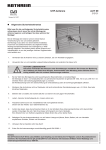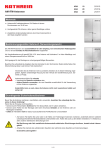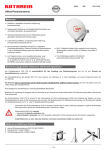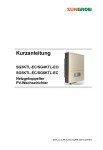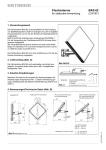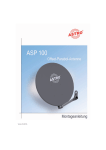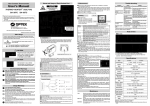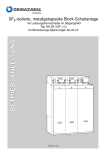Download Kathrein AOT 65
Transcript
UHF-Antennen OLYMPIA geeignet für DVB-T (B IV/V) AOP 52, 212347 AOS 32, 212349 AOS 65, 212352 AOT 65, 212353 Allgemeine Sicherheitshinweise Bitte lesen Sie die nachfolgenden Sicherheitshinweise aufmerksam durch, bevor Sie mit der Montage der Antenne beginnen und befolgen Sie diese während der Montage! Bei der Montage der Antenne wird ein hohes Maß an Verantwortung für sich und andere gefordert. Die Montage muss daher von einem Elektro-Installateur (Fachmann des Elektrohandwerks) durchgeführt werden. Wichtige Sicherheitshinweise sind nachfolgend zur Hilfestellung aufgeführt. Sie erheben jedoch keinen Anspruch auf Vollständigkeit, da uns die jeweiligen örtlichen Gegebenheiten nicht bekannt sind. AOP 52 1. Verwenden Sie die Antenne nicht zu anderen Zwecken, als vom Hersteller angegeben. 2. Verwenden Sie nur vom Hersteller vorgeschriebene Bauteile und verändern Sie diese nicht. 3. ACHTUNG LEBENSGEFAHR! Auf keinen Fall dürfen Sie Antennen unter Stromleitungen montieren! Sie könnten bei Berührung der Freileitung mit Teilen Ihres Körpers, Antennenteilen oder Werkzeug einen tödlichen Stromschlag erleiden oder sich schwere Verbrennungen zuziehen. AOS 32/65 4. Bei der Wahl des Montageortes sind bauwerkstypische Besonderheiten zu berücksichtigen. Bei Montage an Dach- und Gebäudekanten und zylindrischen Bauwerken, ist AOT 65 gemäß DIN 1055, Teil 4 bzw. 4131 mit erhöhten Wind- oder Schwingungsbelastungen zu rechnen. Bei Nichtbeachtung kann eine Überschreitung der Grenzbelastung oder der Schwingungsfestigkeit auftreten. 5. Montieren Sie die Antenne nicht auf Gebäuden mit leicht entzündlichen Dachabdeckungen wie z. B. Stroh, Reet oder ähnlichen Materialien. 6. Betreten Sie nur stabile und trockene Dächer und sichern Sie sich gegen Herunterfallen. 7. Leitern, Gerüste, Sicherheitsgurt etc. müssen sicher sein. 8. Passanten dürfen durch evtl. herabfallende Teile nicht gefährdet werden. Sichern Sie den Arbeits- bzw. Gefahrenbereich ab. 9. Achten Sie darauf, dass die technischen Werte (z. B. die Windlast) Ihres Antennenstandrohres nicht überschritten werden. Erkundigen Sie sich, falls Ihnen diese nicht bekannt sind, beim Hersteller. Eine Übersicht der von Kathrein angebotenen Maste nden Sie auf der letzten Seite. 10. Befestigen Sie das Antennenstandrohr nur auf festem Untergrund (Mauer, Beton, Balken) mit vom Hersteller empfohlenen Schellen, Dübeln und Schrauben. 11. Verlassen Sie bei Gewitter sofort das Dach! 12. Erden Sie die Antennenanlage vorschriftsmäßig gemäß EN 50083-1. Mastmontage und Mastberechnung (Abb. 1) - Achten Sie bei der Montage des Mastes darauf, dass dieser Senkrecht steht - Verwenden Sie nur Masten oder Standrohre, die speziell für die Antennenmontage geeignet sind. Andere Rohre weisen zumeist nicht die erforderliche Festigkeit bei Wind- und Wetterein üssen auf. Kathrein-Maste und Schellen erfüllen diese Voraussetzungen. Eine Übersicht über die von Kathrein angebotenen Maste nden Sie auf der letzten Seite - Der Spannbereich der Mastschelle der OLYMPIA-Antennen beträgt 22 bis 60 mm - Bei einer Mastmontage auf dem Dach muss der Mast mindestens 1/6 seiner Länge eingespannt werden - Achten Sie dabei darauf, dass die Masthalterungen (z. B. Schellen) auf festem Untergrund (Holz, Beton, Mauerwerk) angebracht werden 935.543/C/0707/1.3d/ZWT Hinweis: Die UHF-Antennen OLYMPIA sind ausschließlich zum Empfang von terrestrischen TV-Signalen und als Haushaltsantenne bestimmt. Als Haushaltsantenne gilt gemäß DIN 4131 eine Antenne mit höchstens 6 Metern freier Mastlänge und einem Einspannmoment bis zu 1650 Nm. Kabelanschluss (Abb. 3 - 4) 1. Rändelschraube am Kabelanschlussgehäuse lösen und Deckel abnehmen 2. Kabel abisolieren 3. Kabelanschlussklemme und Zugentlastungsklemme im Deckel öffnen 4. Kabel anschließen und Klemmen festziehen 5. Deckel wieder auf das Anschlussgehäuse aufschrauben 6. Kabel nach den örtlichen Gegebenheiten verlegen, sodass es nicht im Wind attern kann und nicht durchscheuert (verwenden Sie Kabelschellen oder -binder bzw. Isolierband) 7. Um das Eindringen von Wasser in den Mast oder das Mauerwerk zu verhindern, sollten Sie mit dem Kabel einen „Wassersack“ bilden (Abb. 5) Montage mehrerer Antennen an einem Mast Bei Montage mehrerer Antennen an einem Mast, darf keinesfalls die maximale Belastbarkeit des Mastes oder der Schellen überschritten werden. Antennenmontage (Abb. 2) 1. Antennenteile, falls typenbezogen erforderlich, zusammenstecken und mit Flügelschrauben xieren. 2. Dipol mit Kabelanschlussgehäuse am Antennen-Vierkantrohr mittels der Rändelschraube befestigen. 3. Re ektorgitter aufklappen und mit den Flügelschrauben durch das Vierkant-Antennenrohr xieren. 4. Bei den Typen AOS 32, AOS 65 und AOT 65 den Unterzug an den gekennzeichneten Stellen aufsetzen und mit den Flügelschrauben xieren. 5. Mastschelle aufklappen und Antenne am Mast befestigen. Ziehen Sie die Flügelmuttern an der Mastschelle nur leicht an, damit Sie die Antenne noch auf besten Empfang ausrichten können. Hinweis zum Empfang von DVB-T-Signalen Kathrein-Antennen sind werkseitig für den Empfang von horizontal polarisierten Signalen vormontiert. DVB-T-Signale werden jedoch auch in vertikaler Polarisation abgestrahlt. Für den DVB-T-Empfang muss die jeweilige Antenne in Ihrer Längsrichtung zum Sender um 90° gegen den Uhrzeigersinn gedreht montiert werden. Die Drehrichtung ist zu beachten, damit kein Wasser durch den Kabeleinlass in die Anschlussdose dringt. Bei richtiger Montage zeigt der Kabelauslass schräg nach unten und der Kathrein-Schriftzug ist horizontal ausgerichtet lesbar (Abb. 7). Bei falscher Montage steht der Kathrein-Schriftzug auf dem Kopf. Sicherheitshinweis: Zu Ihrer eigenen Sicherheit sollten Sie die nachfolgend beschriebenen Montageschritte auf dem Boden bzw. festem Untergrund und nicht auf dem Dach vornehmen. Montageschritte: Folgende Schritte müssen durchgeführt werden, damit die Antenne für den Empfang von vertikal polarisierten Signalen am Mast montiert werden kann: 1. Die Mastbefestigungsschelle vom Tragrohr durch Lockern der Klemmschrauben lösen 2. Mastbefestigungsschelle abziehen 3. Die Schelle um 90° im Uhrzeigersinn drehen 4. Mastbefestigungsschelle auf das Tragrohr an die vorherige Position aufschieben 5. Klemmschrauben anschließend wieder festziehen. 935.543/C/0707/2.3d/ZWT *) Bei Bauwerkshöhen größer 20 m ist ein Staudruck von 1100 N/m2 anzusetzen. Ausrichten der Antenne Antenne durch Drehen auf besten Empfang ausrichten. Verwenden Sie hierfür gegebenenfalls ein Antennen-Messgerät. Wählen Sie für die Ausrichtung der Antenne ein beliebiges Programm am TV- oder Messgerät. Ziehen Sie nach der Ausrichtung die Flügelschrauben an der Mastschelle fest. Abb. 6: Horizontale Ausrichtung Abb. 7: Vertikale Ausrichtung Technische Daten der Antennen Typ AOP 52 AOS 32 AOS 65 AOT 65 Bestell-Nr. 212347 212349 212352 212353 Kanäle 21...52 21...32 21...65 21...65 dB 11...15 15,5...17 11...17 12...18 Gewinn Empfangsbereich MHz 470...726 470...566 470...830 470...830 horiz.° 43...26 26...21 43...21 37...18 vert.° 52...32 30...23 47...23 39...19 dB 24...30 27...31 25...32 23...32 mm 1380 2830 2240 2820 Windlast bei 800 N/m2 N 108 203 179 192 Grenzwindlast bei 1100 N/m2 N 148 287 246 263 Verpackungseinheit/Gewicht St./kg 1/2,3 1/3,8 1/3,5 1/3,7 Maße der Einzelverpackung mm 890 x 520 x 100 1080 x 520 x 130 960 x 520 x 130 1080 x 520 x 130 Halbwertsbreite Rückdämpfung Spannbereich Mastschelle Länge mm Ø 22...60 Mastübersicht Typ Bestell-Nr. Länge ZSD 48 ZSF 47 ZSF 48 ZSH 47 ZSH 48 218380 218385 218381 218386 218394 L/m 2x2=4 D1/D2/mm 2 x 2,5 = 5 ZSH 59 ZSH 622) 218382 218383 48/60 2x3=6 40/48 40/48 40/48 40/48 40/48 48/60 Kabeleinführungen 3 - 3 - 3 5 5 Güteklasse (Stahl) St 52 St 37 St 52 St 37 St 52 St 52 St 52 Durchmesser Wandstärke im Einspannbereich mm 2,5 2 2,5 2 2,5 2,5 4,5 Zul. Biegemoment1) Nutzlänge 5,0 m - - - 320 850 1150 1950 (1150) bei 800 N/m2 4,0 m - 500 1040 430 960 1280 2120 (1280) 3,0 m 1170 540 1080 - - - - Zul. Biegemoment1) Nutzlänge 5,0 m - - - 160 700 900 1700 (900) bei 1100 N/m2 4,0 m - 390 920 300 840 1080 1960 (1080) 3,0 m 1110 480 1000 - - - - kg 1/11,4 1/11,3 1/14,2 1/13,1 1/17,8 1/20,5 1/37,5 Verpackungseinheit/Gewicht ) Das max. zul. Moment an der Einspannstelle gilt bei entsprechender Nutzlänge. Die Windlastaufnahme des Rohres ist bereits berücksichtigt. Die fettgedruckten Werte gelten für normale Windbelastung (q = 800 N/m2). Bei höherer Windbelastung (q = 1100 N/m2) sind die reduzierten Werte anzuwenden. Nach EN 50083-1 muss die Masteinspannlänge mindestens 1/6 der Mastlänge betragen. 2 ) Den technischen Daten liegen die Berechnungsgrundlagen nach DIN 4131 zugrunde. Überschreitet die Summe der Antennen-Windlastmomente die in Klammern angegebenen Werte (≙ 1650 Nm am Einspannpunkt), ist gemäß DIN EN 50083, Teil 1, ein statischer Nachweis zu führen. Internet: http://www.kathrein.de KATHREIN-Werke KG . Anton-Kathrein-Straße 1 – 3 . Postfach 10 04 44 . D-83004 Rosenheim . Deutschland . Telefon (0 80 31) 1 84-0 . Fax (0 80 31) 1 84-3 06 935.543/C/0707/3.3d/ZWT 1 OLYMPIA UHF Antennas Suitable for DVB-T (B IV/V) AOP 52, 212347 AOS 32, 212349 AOS 65, 212352 AOT 65, 212353 General safety instructions Please read the following safety instructions carefully and thoroughly before you start installing the antenna, and keep observing them during the installation. The installation of the antenna demands a high degree of responsibility for yourself and other people. For this reason, the installation must be executed by an electrician (expert on his/her trade). In order to assist you, some important safety instructions have been compiled in the following. However, these instructions are not exhaustive, as we are not aware of the local conditions. AOP 52 1. Do not use the antenne for purposes other than intended by the manufacturer. 2. Only use the components as prescribed by the manufacturer and do not modify them. 3. ATTENTION! DANGER FOR LIFE! Do never mount an antenna under power supply lines! Touching power supply lines with parts of your body, with antenna parts or tools may cause an electrical shock or serious burns. 4. When selecting the antenna site, you must consider the structural characteristics of the building. Installation on the edge of rooftops or buildings and on cylindrical structures could lead to increased wind loads and vibration stress according to DIN 1055, part 4, or DIN 4131. Non-observance of these instructions may cause exceeding of the load limit or the vibration resistance. AOS 32/65 AOT 65 5. 6. 7. 8. 9. Do not install the antenna on buildings with easily in ammable materials as rooftop, such as straw, reed or similar materials. Only step on rm, dry rooftops and protect yourself against falling down. Ladders, scaffoldings, safety belts etc. must be in good order. Passers-by must not be endangered by falling objects. Secure the work/danger area. Mind that the technical values (e.g. wind load) of the antenna mast are not exceeded. Refer to the manufacturer if you do not know these values. Find an overview of the masts offered by Kathrein on the last page. 10. Mount the antenna mast on solid ground only (walls, concrete, rafters) using the clamps, dowels and screws recommended by the manufacturer. 11. Immediately leave the roof in case of a thunderstorm! 12. Ground the antenna installation according to EN 50083-1. Notice: The OLYMPIA UHF antennas were designed solely for the limited purpose of receiving terrestrial TV signals and as indoor antennas. Under the terms of DIN 4131, an antenna is reckoned an indoor antenna if the mast length does not exceed 6 metres and if the torque needed for screwing the antenna is at 1,650 Nm at maximum. 935.543/C/0707/1.3e/ZWT Mast installation and mast calculation (Fig. 1) - Make sure that the mast is in vertical position when mounting it - Only use masts or standpipes specially designed for antenna installation. Other tubes mostly do not have the necessary stability to withstand heavy wind or other climatical situations. Kathrein-masts and clamps ful l these requirements. Find an overview of the masts provided by Kathrein on the last page - The clamping range of the mast clamp of the OLYMPIA antennas is from 22 mm to 60 mm - If the mast is to be mounted on a roof, you have to clamp at least 1/6 of its length - Mind that the mast holders (e.g. clamps) are mounted on solid ground (wood, concrete, walls) Cable connection housing (Fig. 3 - 4) 1. Unscrew the milled nut on the cable connection housing and remove the cover. 2. Isolate the cable. 3. Open the cable pull-secure clamp and the cable connection clamp. 4. Connect the cable and clamp in rmly. 5. Replace the cover and screw down rmly. 6. Install the cable so that it does not atter or is under any friction (e.g. with cable ties, isolating band or cable clamps). 7. To ensure that no water can ow into the mast or seep into walling lay the cable with a drip-bend ( g. 5). *) On buildings higher than 20 stories, a dynamic pressure of 1100 Nm ≤ is considered. Installing several antennas on one mast Never exeed the maximum load capacity of the mast or clamps when mounting several antennas on the mast. Antenna installation (Fig. 2) 1. If necessary, plug together the antenna parts, and x them using wing screws. 2. Fix the dipole with cable connection box on the antenna square pipe using a knurled screw. 3. Open the re ector grille and x it with the wing screws through the antenna square pipe. 4. For the types AOS 32, AOS 65 and AOT 65 place the bowboom on the marked positions and af x rmly using the provided butterly nuts. 5. Open up the mast clamp and af x the antenna to the mast. Primarily, only screw down the xing screws lightly to allow one to align the antenna for best reception. Antenna alignment Align the antenna for optimum reception by turning it. If necessary, use an antenna measurement device. Select any programme on the TV set or the measurement device for the antenna alignment. After nishing the alignment, tighten the wing screws on the mast clamp. Indication of the reception of DVB-T signals Kathrein antennas are pre-assembled for the reception of horizontally polarised signals. However, DVB-T signals are also transmitted in vertical polarisation. For DVB-T reception, turn the antenna in its longitudinal alignment to the transmitter rotated 90° counterclockwise. Observe the direction of rotation, as otherwise moisture can ingress in the connection box through the cable entry. If the antenna was properly mounted, the cable outlet points slantwise down, and the Kathrein-writing is legible horizontally-aligned (Fig. 7). If not, the Kathrein-writing is upside-down. Safety instruction: For your own safety, it is recommended that you carry out the mounting steps specified in the following on solid ground and not on the rooftop. Fig. 2 935.543/C/0707/2.3e/ZWT Mounting steps: The following steps must be carried out in order to be able to mount the antenna on the mast so that vertically polarised signals can be received: 1. Unfasten the mast clamp from the axle tube by loosening the clamping screw 2. Pull off the mast clamp 3. Rotate the clamp 90° clockwise 4. Slide the mast clamp on the previous position on the axle tube 5. Then tighten the clamping screws again. Abb. 6: Horizontal alignment Abb. 7: Vertical alignment Technical data of the antennas Type AOP 52 AOS 32 AOS 65 AOT 65 Order Number 212347 212349 212352 212353 Channels 21...52 21...32 21...65 21...65 dB 11...15 15,5...17 11...17 12...18 MHz 470...726 470...566 470...830 470...830 horiz.° 43...26 26...21 43...21 37...18 vert.° 52...32 30...23 47...23 39...19 Front-to-back-ratio dB 24...30 27...31 25...32 23...32 Mast clamp range mm Ø mm 1380 2830 2240 2820 Wind load at 800 N/m2 N 108 203 179 192 Limiting wind load at 1100 N/m2 N 148 287 246 263 St./kg 1/2,3 1/3,8 1/3,5 1/3,7 mm 890 x 520 x 100 1080 x 520 x 130 960 x 520 x 130 1080 x 520 x 130 Gain Reception range Full width at half maximum Length Packing unit/weight Packing unit dimensions 22...60 Overview of the Kathrein antenna masts Type Order Number Lenght L Diameter D1/D2 ZSF 48 ZSH 47 ZSH 48 218380 218385 218381 218386 218394 2 x 2,5 = 5 ZSH 59 ZSH 622) 218382 218383 48/60 2x2=4 D1/D2/mm 40/48 40/48 40/48 40/48 40/48 48/60 3 - 3 - 3 5 5 St 52 St 37 St 52 St 37 St 52 St 52 St 52 mm 2,5 2 2,5 2 2,5 2,5 4,5 5,0 m - - - 320 850 1150 1950 (1150) 2120 (1280) Quality category (steel) Allowable bending moment 1), ZSF 47 L/m Cable entry points Wall thickness in clamping range ZSD 48 2x3=6 4,0 m - 500 1040 430 960 1280 3,0 m 1170 540 1080 - - - - Allowable bending moment 1), 5,0 m - - - 160 700 900 1700 (900) Effectice length at 800 N/m2 4,0 m - 390 920 300 840 1080 1960 (1080) 3,0 m 1110 480 1000 - - - - kg 1/11,4 1/11,3 1/14,2 1/13,1 1/17,8 1/20,5 1/37,5 Effective length at 800 N/m2 Packing unit/weight ) The maximum allowable moment on the clamping point applies for the appropriate effectice length. The wind load absorption of the tube has already been allowed for. The bold values apply for an ordinary wind load (q = 800 N/m2). In case of increased wind load (q = 1100 N/m2), the reduced values apply. According to EN 50083-1, the mast clamping length must be at least 1/6 of the mast length. 2 ) The technical data underlie the computation base according to DIN 4131. If the sum of the antenna wind load moments exceeds the values put in parentheses (≙ 1650 Nm am Einspannpunkt), a structural analysis is required, according to EN 50083, part 1. Internet: http://www.kathrein.de KATHREIN-Werke KG . Anton-Kathrein-Straße 1 – 3 . Postfach 10 04 44 . D-83004 Rosenheim . Deutschland . Telefon (0 80 31) 1 84-0 . Fax (0 80 31) 1 84-3 06 935.543/C/0707/3.3e/ZWT 1
This document in other languages
- Deutsch: Kathrein AOP 52








